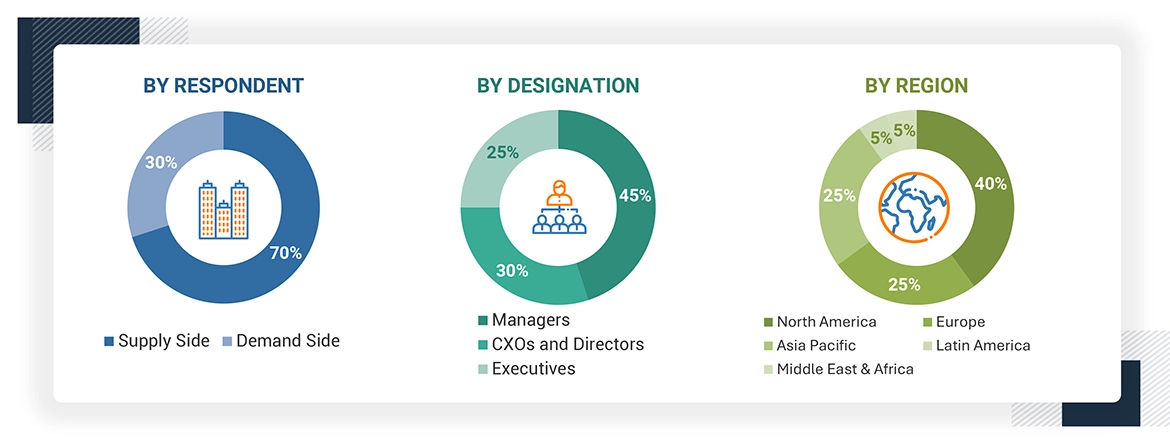This study on the gene editing market employed secondary sources, directories, and databases to gather pertinent information. To gather and validate important qualitative and quantitative data and evaluate market growth prospects, in-depth interviews were conducted with many primary respondents including key industry participants, subject-matter experts (SMEs), C-level executives from key market players, and industry consultants. After estimating the gene editing market using several research strategies, the size of the final market was obtained by triangulating data from primary research.
Secondary Research
The secondary sources referred to for this research study include publications from government sources, such as the International Chromosome and Genome Society (ICGS), the National Human Genome Research Institute (NHGRI), the Asia Pacific Society of Human Genetics (APSHG), the Genetics Society of America (GSA), the European Society of Human Genetics (ESHG), Centers for Common Disease Genomics (CDDG), Centre for Cellular & Molecular Biology (CCMB) (India), and the Department of Biotechnology (DBT) (India). Secondary sources include corporate and regulatory filings, such as annual reports, SEC filings, investor presentations, and financial statements; business magazines & research journals; press releases; and trade, business, and professional associations. Secondary data was collected and analyzed to arrive at the overall size of the global gene editing market, which was validated through primary research.
Primary Research
Extensive primary research was conducted after acquiring basic knowledge about the global gene editing market scenario through secondary research. Several primary interviews were conducted with market experts from the supply side, such as C-level and D-level executives, operational managers, marketing & sales managers of key manufacturers, distributors, and channel partners of companies providing gene editing products and services; experts from the demand side, such as personnel from pharmaceutical & biotechnology companies, Academic & research institutes, and CROs & CDMOs. These interviews were conducted across six major regions, including North America, Europe, the Asia Pacific, Latin America, the Middle East, and Africa. Approximately 70% and 30% of the primary interviews were conducted with supply-side and demand-side participants, respectively. This primary data was collected through questionnaires, e-mails, online surveys, personal interviews, and telephonic interviews.
The following is a breakdown of the primary respondents:

To know about the assumptions considered for the study, download the pdf brochure
Market Size Estimation
Both top-down and bottom-up approaches were used to estimate and validate the total size of the gene editing market. These methods were also used extensively to estimate the size of various subsegments in the market. The research methodology used to estimate the market size includes the following:
Bottom-up Approach
-
The key players in the industry and market have been identified through extensive secondary research.
-
The revenues generated from the gene editing market business of leading players have been determined through primary and secondary research.
-
All percentage shares, splits, and breakdowns have been determined using secondary sources and verified through primary sources.
Top-down Approach
After arriving at the overall market size from the market size estimation process, the total market was split into several segments and subsegments.
Data Triangulation
To complete the overall market engineering process and arrive at the exact statistics for all segments and subsegments, data triangulation and market breakdown procedures were employed, wherever applicable. The data was triangulated by studying various factors and trends from both the demand and supply sides.
Market Definition
The gene editing market, as covered within the scope of this report, includes products, technologies, and services that facilitate genetic modifications across various applications. This encompasses reagents and consumables, as well as software and systems for planning, executing, and analyzing gene editing processes. Additionally, the report covers services that utilize gene editing technologies like CRISPR, TALEN, ZFN, and other methods such as Meganucleases, PiggyBac, and Prime Editing, applied in areas like cell line engineering, genome editing, drug discovery, clinical diagnostics, and xenotransplantation. These components serve end users, including pharmaceutical and biotechnology companies involved in therapeutic development, as well as academic and research institutes focused on scientific research.
Stakeholders
-
Manufacturers and distributors of gene editing products and services
-
Pharmaceutical and biotechnology companies
-
Market research and consulting firms
-
R&D centers
-
Researchers and scientists
-
Academic & research institutes
-
CDMOs & CROs
-
Biobanks
-
Diagnostic companies.
Report Objectives
-
To define, describe, segment, and forecast the gene editing market based on offerings, product type, product application, product technology, reagent & consumables technique, product end user, service type, service application, service end user and region
-
To provide detailed information about the factors influencing market growth, such as drivers, restraints, opportunities, and challenges
-
To strategically analyze micromarkets1 with respect to individual growth trends, prospects, and contributions to the overall gene editing market
-
To analyze market opportunities for stakeholders and provide details of the competitive landscape for key players
-
To forecast the size of the market segments concerning six main regions: North America, Europe, the Asia Pacific, Latin America, the Middle East, and Africa.
-
To strategically profile the key players in the global gene editing market and comprehensively analyze their core competencies2 and market rankings.
-
To track and analyze competitive developments, such as product launches, acquisitions, collaborations, expansions, and partnerships in the gene editing market.
-
To profile the key players in the global gene editing market and comprehensively analyze their instruments, reagents, kits, consumables, and services portfolios, market positions, and core competencies
-
To track and analyze competitive developments such as product & service launches, expansions, agreements, and collaborations in the gene editing market
-
To benchmark players within the gene editing market using the ‘Company Evaluation Matrix' framework, which analyzes market players based on various parameters within the broad categories of business and service strategy



Growth opportunities and latent adjacency in Gene Editing Market